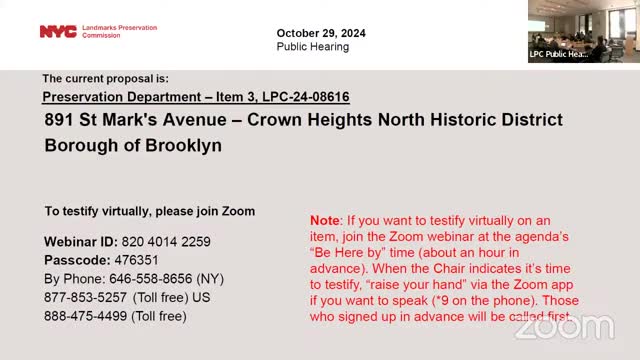Reconstruction plan sparks debate over historic preservation
October 29, 2024 | Land Preservation Commission, New York City Board & Committees, New York City, New York County, New York
This article was created by AI summarizing key points discussed. AI makes mistakes, so for full details and context, please refer to the video of the full meeting. Please report any errors so we can fix them. Report an error »

In a recent government meeting, the commission reviewed an application for the reconstruction of the historic stoop and balustrade at 891 St. Marks Avenue, located in the Crown Heights North Historic District. The building, part of a row of Renaissance Revival style row houses built in 1910, has suffered significant deterioration over the years, prompting the need for repairs.
The applicant presented a detailed plan to reconstruct the stoop, which has been modified and damaged, including corroded structural elements and leaning cheek walls. The proposed work includes using concrete masonry units (CMUs) clad with stucco and bluestone-tinted cast stone, while retaining existing bluestone curbing and limestone units where possible. The steps are to be constructed with bluestone-tinted concrete.
Public testimony highlighted concerns from preservation advocates, including representatives from the Victorian Society in New York and the Historic Districts Council. They argued for the preservation of original materials, emphasizing that the historic character of the stoop should be maintained and that the use of stucco and cast stone was inappropriate. They urged the commission to require the applicant to salvage and reuse as much of the original limestone and bluestone as possible.
The commission members expressed mixed views on the proposed materials. Some supported the use of alternative materials due to the deteriorated condition of the existing structure, while others raised concerns about the aesthetic implications of mixing materials and the importance of maintaining the historic integrity of the row houses. Ultimately, the commission agreed on the necessity of working closely with staff to ensure that any new materials closely match the original in appearance and texture.
The hearing concluded with a motion to approve the application, contingent upon the applicant collaborating with staff to finalize the material choices and ensure the preservation of the historic character of the stoop. The decision reflects a balance between the need for structural integrity and the commitment to preserving the neighborhood's architectural heritage.
The applicant presented a detailed plan to reconstruct the stoop, which has been modified and damaged, including corroded structural elements and leaning cheek walls. The proposed work includes using concrete masonry units (CMUs) clad with stucco and bluestone-tinted cast stone, while retaining existing bluestone curbing and limestone units where possible. The steps are to be constructed with bluestone-tinted concrete.
Public testimony highlighted concerns from preservation advocates, including representatives from the Victorian Society in New York and the Historic Districts Council. They argued for the preservation of original materials, emphasizing that the historic character of the stoop should be maintained and that the use of stucco and cast stone was inappropriate. They urged the commission to require the applicant to salvage and reuse as much of the original limestone and bluestone as possible.
The commission members expressed mixed views on the proposed materials. Some supported the use of alternative materials due to the deteriorated condition of the existing structure, while others raised concerns about the aesthetic implications of mixing materials and the importance of maintaining the historic integrity of the row houses. Ultimately, the commission agreed on the necessity of working closely with staff to ensure that any new materials closely match the original in appearance and texture.
The hearing concluded with a motion to approve the application, contingent upon the applicant collaborating with staff to finalize the material choices and ensure the preservation of the historic character of the stoop. The decision reflects a balance between the need for structural integrity and the commitment to preserving the neighborhood's architectural heritage.
View full meeting
This article is based on a recent meeting—watch the full video and explore the complete transcript for deeper insights into the discussion.
View full meeting
